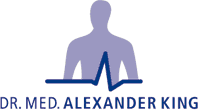Services
The following is an overview of our diagnostic procedures (examinations). It is designed to guide you through our practice, answer your questions, provide additional information, and make your visit to our practice as comfortable as possible.
1. Consultation
First, we ask you to complete a questionnaire. This information is supplemented with an in-depth personal consultation.
2. Physical examination
Depending on the symptoms, different organ systems are examined using a stethoscope and the five senses.
3. Technical examination
3.1. ECG (Electrocardiogram)
An ECG can be used to record heart activity at any point in time.The ECG provides information on arrhythmia and acute or existing disease of the heart muscle.
3.2. Long-term ECG (24 hours)
During this examination, cardiac rhythm is measured continuously over a 24-hour period using a small recorder (pocket-sized) given to the patient. This allows pathological changes in the heart’s electrical activity to be diagnosed precisely.
3.3. Long-term blood pressure measurement
Over a 24-hour period, blood pressure is measured by means of a small recorder with a connected cuff. Blood pressure is measured automatically at 15-minute intervals during the day and 30-minute intervals at night and a precise blood pressure profile is created. Pathological blood pressure changes can thus be determined precisely and treated as required.
3.4. Spirometry (pulmonary function test) The capacity of your lungs is measured electronically using different breathing exercises. No preparation is required, but your cooperation is important. Asthma, allergies, and other pulmonary diseases can be diagnosed using these exercises.
3.5. Sonography (ultrasound)
Sonography is a modern examination method used to examine a variety of regions of the body by means of ultrasonic waves without any exposure to radiation. You should have an empty stomach for the abdominal cavity examination, since intestinal gas could negatively affect the image. The function, blood flow, and condition of the heart and vessels are examined during special ultrasound examinations, doppler and duplex sonography. Your bladder should be full for an ultrasound examination of the prostate. The thyroid can be examined using ultrasound at any time.
3.6. Lab diagnostics
Nowadays, many examinations are performed by examining different body substances (blood, urine, stool, etc.) in the lab. You do not always have to have an empty stomach for these procedures. We will give you specific instructions for the various tests. If during an examination, medical check-up, or health check-up, we should diagnosis a condition that needs to be treated, we will strive to find the best solution for your health problem.
We are here to help and support you on the road to recovery, whatever form it might take. In the meantime, your suggestions on how to improve our practice are always welcome. We aim to offer you personal and high-quality medical care.
4. Screening examinations
Public health insurance companies offer health check-ups for their members starting at age 35. During these checks, your medical history is noted and a physical examination is performed. Furthermore, your cholesterol and blood sugar levels are determined and a urinalysis carried out. If needed and desired, this basic prevention can be supplemented with other medically appropriate examinations. Private health insurance providers reimburse regular and comprehensive preventive medical check-ups, such as:
– Cancer screening
– Cardiovascular check-up
– Stroke prevention screening
– Comprehensive internal medicine lab services, preventative care and screening, examination and tests
You can find a more detailed description of screening examinations here.
